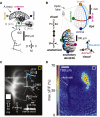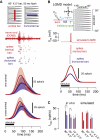Precise subcellular input retinotopy and its computational consequences in an identified visual interneuron
- PMID: 19778511
- PMCID: PMC2774212
- DOI: 10.1016/j.neuron.2009.09.010
Precise subcellular input retinotopy and its computational consequences in an identified visual interneuron
Abstract
The Lobula Giant Movement Detector (LGMD) is a higher-order visual interneuron of Orthopteran insects that responds preferentially to objects approaching on a collision course. It receives excitatory input from an entire visual hemifield that anatomical evidence suggests is retinotopic. We show that this excitatory projection activates calcium-permeable nicotinic acetylcholine receptors. In vivo calcium imaging reveals that the excitatory projection preserves retinotopy down to the level of a single ommatidium. Examining the impact of retinotopy on the LGMD's computational properties, we show that sublinear synaptic summation can explain orientation preference in this cell. Exploring retinotopy's impact on directional selectivity leads us to infer that the excitatory input to the LGMD is intrinsically directionally selective. Our results show that precise retinotopy has implications for the dendritic integration of visual information in a single neuron.
Figures






References
-
- Anderson JC, Binzegger T, Kahana O, Martin KA, Segev I. Dendritic asymmetry cannot account for directional responses of neurons in visual cortex. Nat Neurosci. 1999;2:820–4. - PubMed
-
- Baden T, Hedwig B. Neurite-specific Ca2+ dynamics underlying sound processing in an auditory interneurone. Dev Neurobiol. 2007;67:68–80. - PubMed
-
- Borst A, Egelhaaf M, Haag J. Mechanisms of dendritic integration underlying gain control in fly motion-sensitive interneurons. J Comput Neurosci. 1995;2:5–18. - PubMed
Publication types
MeSH terms
Substances
Grants and funding
LinkOut - more resources
Full Text Sources

